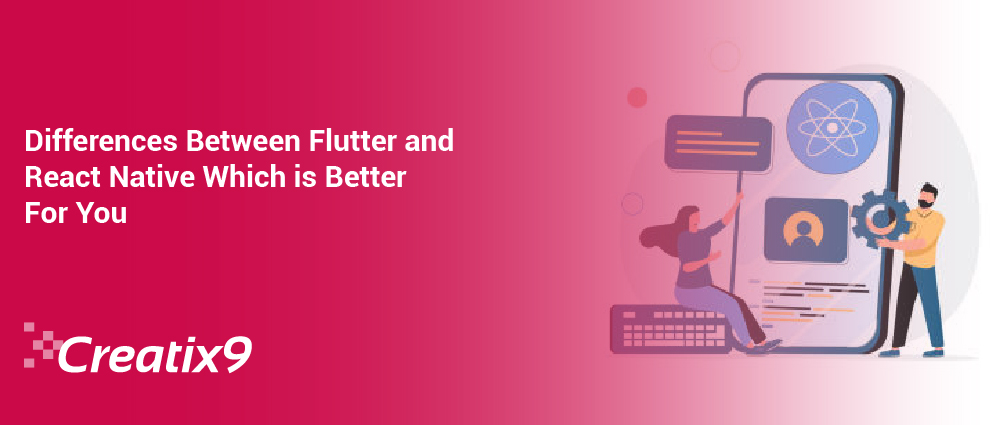
Today, the market for smartphones applications is increasing rapidly. The number of potential clients is practically infinite now that nearly everyone has a smartphone. Now, any business needs to have a mobile app to maintain market share.
Several different ways use to build applications. You can use native approaches, which require developing in the appropriate language for each target platform (Kotlin and Java for Android while Objective-C and Swift for iOS). Alternatively, cross-platform development is a technique where developers write code only once and have it run on all mobile platforms. For this task, there are dedicated frameworks, with Flutter and React Native now enjoying widespread use.
Developer interest in Flutter has been growing steadily over the past few years, and the framework currently occupies the top spot in Statista’s 2021 list. It is being overtaken by React Native, which is a severe warning.
This post by Creatix9 US, which efficiently works on react native mobile apps and cross-platform app development, will compare and contrast two popular mobile app development frameworks in detail: Flutter and React Native. First, let’s know what they are.
What Does “Flutter” Entail?
Flutter is a Google SDK that debuted in 2017. Tools for creating mobile apps that run on several platforms, web apps, desktop apps, and embedded solutions, all from the same source code, are available for free and open source here. With Flutter, you can build minimum viable products (MVPs) and feature-complete apps (Full apps). Internally, Flutter is written in C/C++ and Dart and relies on the app development framework Dart.
What Does “React Native” Entail?
The React Native framework is robust, lightweight, and open-source. You won’t find a more widely used JavaScript framework than this one. Much like Flutter, it embraces using a single code base to target various platforms. It enables the creation of apps that run equally well on multiple operating systems, like iOS, Android, Windows, and macOS.
Because it uses the React library architecture and JavaScript language, React Native facilitates the development of web-based versions of applications and provides relatively quick time to develop and problem fixes.
Differentiating Flutter from React Native: The Key Dissimilarities
Here is the comparison Flutter and react Native on the bases of their features.
Language For Programming
To create an app using Flutter, you must familiarise yourself with Dart, a new programming language. Dart is a more contemporary programming language that first surfaced in 2011. Google created it to compete with JavaScript. The language is well-documented with thousands of examples and is object-oriented with elegant code, making the transition nearly effortless.
JavaScript is the language used by React Native, and it is a well-established one with a plethora of online resources and millions of users worldwide. JavaScript plays an integral part in dynamic web development. In contrast, Dart can affect dual JavaScript performance by utilizing just-in-time and ahead-of-time compilers.
As a result, Flutter and Dart are the best choices if you care primarily about performance. In contrast, React Native and JavaScript are the best choices if you care mainly about maturity and a large pool of talented developers.
Architecture
It is necessary to think about the technical architecture of a cross-platform app development environment before making a final decision. When you understand how a framework works, you can pick the one that’s best for your project.
React Native borrows substantially from the JavaScript Bridge approach in its architecture. During the running time, JavaScript code is compiled into machine code. Facebook’s Flux framework is at the heart of React Native. This platform uses a custom JavaScript bridge to facilitate module interaction, resulting in a slower application.
Most of Flutter’s components are already present in the Dart programming language. As a result, it is more extensive and can usually perform with its modules with no additional space needed. Dart’s various available frameworks, like Cupertino and Material Design, contain all the essential techniques required to create mobile applications. In order, Dart uses the C++-based Skia graphics engine. As a result of having all critical core components in the engine itself, Flutter can produce speedier apps.
Installation
If you’re familiar with the Node.js NPM package manager, you can use that to set up React Native. The installation process for React Native is straightforward for developers with prior knowledge of JavaScript. Developers outside your team will need to get up to speed on the fundamentals of using the NPM package manager.
Downloading the platform-specific binaries from GitHub or the zip archive from the official website are viable options for installing Flutter. Further, we must add the bin folder in a system environment variable. It’s a process that requires more steps than using React Native.
Thus, neither React Native nor Flutter offers an OS-specific package manager that allows for a single-command installation. Nevertheless, because of the extra work involved, the installation of Flutter takes more time.
UI and Development API
React Native uses Android UI components and native iOS and to render user interfaces to have right to use to devices. React Native primarily relies on third-party libraries to access most native modules through them.
Instead of using built-in UI elements, Flutter provides its own set of web widgets produced from scratch. Flutter UI development requires substantial customization due to its dependence on UI rendering components, stateful management, device API access, testing, navigation, and many libraries. This comprehensive collection of features allows no usage of external libraries. Everything necessary to create a mobile app is included in Flutter.
Preparation Period
Developers with a background in JavaScript will find it simple to start with React Native. When making changes to the user interface, a hot reload function is a huge time saver during testing. Regarding IDE (integrated development environment) support, developers can use any development environment or text editor, which is another time-saver.
Hot reloading is also available in Flutter. Yet, developers must spend more time learning new Flutter ideas as the programme gets more complicated. Dart isn’t widely used. Thus, many integrated development environments (IDEs) and text editors need to support it, which could add extra time to the process.
Code Reusability
Flutter has more options for code reuse than React Native, yet both frameworks support this. To implement new business logic in Flutter, you must modify a single line of code and continue using the same code base. It’s not always easy to reuse code with React Native because it isn’t necessarily compatible with all mobile platforms. As a result, developers must occasionally investigate alternative parts and make modifications to the codebase.
Quality Control
As a JavaScript framework, React Native benefits from the many unit testing options available in JavaScript. Nevertheless, React Native offers no formal support for integrations or UI testing. It is possible to test a React Native app with different third-party tools, such as Appium or Detox.
Nonetheless, Flutter provides a wealth of tools for testing an application’s modules, widgets, and integrations. Much care was taken to document the platform to perform the app testing efficiently.
DevOps and CI/CD Upkeep
 However, no official documentation exists for establishing continuous delivery in React Native. Yet, there are numerous online articles covering the subject. This article will teach you how to use Azure DevOps to create a CD pipeline for a React Native project.
However, no official documentation exists for establishing continuous delivery in React Native. Yet, there are numerous online articles covering the subject. This article will teach you how to use Azure DevOps to create a CD pipeline for a React Native project.
The Flutter framework has an external link-filled section about continuous integration. Continuous delivery can be easily set up because of Flutter’s well-developed command line interface. In contrast, to React Native, which does not provide formal instructions for this technique, Flutter applications can be configured for these services.
Performance
When comparing frameworks, speed is crucial, and Flutter comes out on top. The framework’s Skia graphics library and C++ engine enable the rapidly developing of high-performance apps for several platforms.
React Native uses a bridge to enable communication between native code and JavaScript. This can cause delays in the UI rendering process and other performance concerns. Flutter does not require this technique because it connects native elements using in-built libraries and frameworks.
Documentation
Flutter also conquests this category thanks to its comprehensive documentation. Inexperienced developers can pick this framework with confidence because of the thorough documentation. The documentation for React Native requires significantly more expertise with JavaScript and is much more difficult to follow.
Why Choose Creatix9 US as Your Flutter or React Native Development Partner?
 With offices around the USA and nearly three decades of experience, Creatix9 US is a global leader in the software development industry. Our custom software engineering services are aimed at established businesses and fledgling enterprises in various sectors, including e-commerce, telecommunications, healthcare, automotive, and more. The experts who make up our Flutter or react native mobile apps development teams use cutting-edge technologies and always adhere to industry standards.
With offices around the USA and nearly three decades of experience, Creatix9 US is a global leader in the software development industry. Our custom software engineering services are aimed at established businesses and fledgling enterprises in various sectors, including e-commerce, telecommunications, healthcare, automotive, and more. The experts who make up our Flutter or react native mobile apps development teams use cutting-edge technologies and always adhere to industry standards.
Conclusion
When developing for several platforms, you can’t go wrong with either Flutter or React Native. While the two can share some similarities, there are important distinctions to remember when determining which to use. Both are cutting-edge, widely used, and suitable for enterprise-level, cross-platform endeavours.
It is necessary to examine the project’s needs in detail to select the best course of action and assess the benefits and drawbacks of Flutter react native mobile apps development. If you require support, our experts of the best cross-platform app development and mobile game developers are here to provide it.

